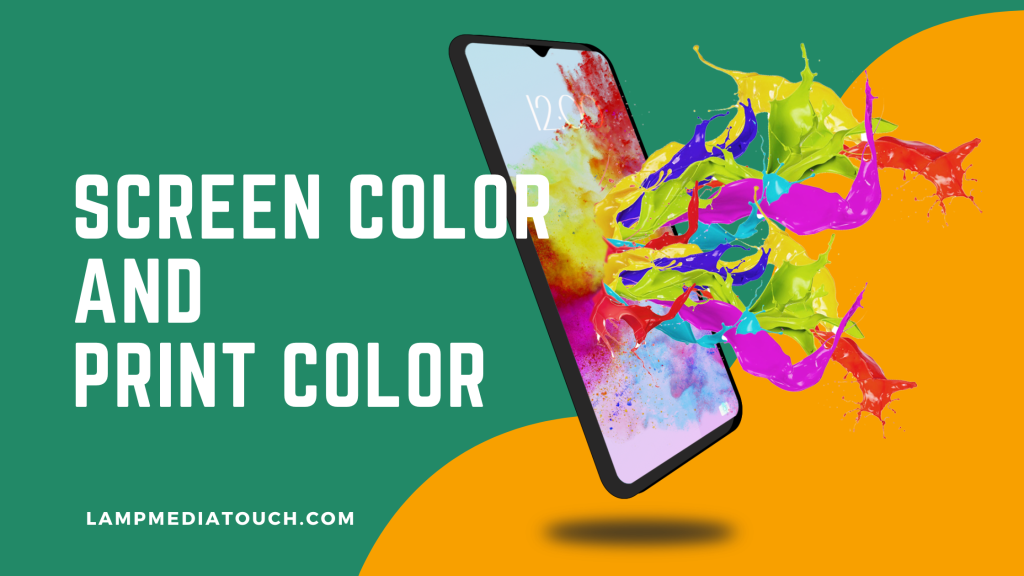Have you ever printed out a design and noticed that the colors look slightly different from how they appeared on your screen? At Lampmediatouch, we often receive requests from clients to print their designs exactly as they appear on their mobile phone screens. However, it’s important to understand that there is a difference between screen color and print color, and colors may appear differently on screen and in print.
In this article, we’ll explain the difference between screen color and print color, why colors may appear differently on screen and in print, and how to ensure accurate color representation in your prints. Whether you’re a graphic designer or a client sending in a design, this information will help you create high-quality prints that look their best.
Table of Contents
What is the difference between screen color and print color?
The difference between screen color and print color can be explained by the difference between additive and subtractive color. Screen color is made by mixing colored light (RGB – Red, Green, Blue) using the additive color model, while print color is made by mixing colored ink (CMYK – Cyan, Magenta, Yellow, Key/Black) using the subtractive color model.
In the additive color model, colors are created by adding different colored lights together. The primary colors of additive color are red, green, and blue (RGB). Additive color starts with black and adds red, green, and blue light to produce the visible spectrum of colors. As more color is added, the result is lighter. When all three colors are combined equally, you get white light.
In contrast, the subtractive color model begins with white and ends with black. Subtractive colors are created by subtracting certain wavelengths of light from white light using pigments or dyes. The primary colors of subtractive colors are cyan, magenta, and yellow (CMY). As you add more color, the resulting color becomes darker. If you print C, M, and Y on paper, they absorb light, which means that your eyes receive no reflected light from the paper and see black.
This means that colors may appear differently on screen and in print due to the different ways that colors are created. For example, 100% saturation of screen color equals bright white, while 100% saturation of ink color is dark black.
How can I ensure accurate color representation in my prints?
If accurate color representation is important for your project (e.g., for a logo, ), it’s important to note all the formulas and use them consistently. For screen colors, use RGB or Hex codes, while for print colors use CMYK or PMS (Pantone Matching System) codes.
When designing your artwork for print, be sure to set the document color mode to CMYK. This will provide the closest representation of colors that you see on screen vs what’s actually printed. Keep in mind that even though you may be viewing CMYK mode on screen, these are still colors that are created by light. This means that CMYK on the screen will look different from CMYK that’s been printed.
Conclusion
There is a difference between screen color and print color, and colors may appear differently on screen and in print. By understanding the different ways that colors are created on screen and in print, you can ensure accurate color representation in your prints.
At Lampmediatouch, we have years of experience in digital printing and graphic design services. If you have any questions about the difference between screen color and print color or need help with your printing project, feel free to contact us for more information and assistance.
What is the difference between screen color and print color?
Screen color is specified differently from print color. Screen color is made by mixing colored light (RGB – Red, Green, Blue), while print color is made by mixing colored ink (CMYK – Cyan, Magenta, Yellow, Key/Black).
Why do colors appear differently on screen and in print?
Colors may appear differently on screen and in print due to the different ways that colors are created. On screen, colors are created by mixing light beams together (RGB), while in print, colors are created by mixing ink together (CMYK). Other factors such as device settings or paper material can also affect how colors appear.
How can I ensure accurate color representation in my prints?
To ensure accurate color representation in your prints, use consistent formulas for specifying colors (RGB or Hex for screen colors; CMYK or PMS for print colors). When designing your artwork for print, set the document color mode to CMYK.

